How NOT to Fit a Bearing
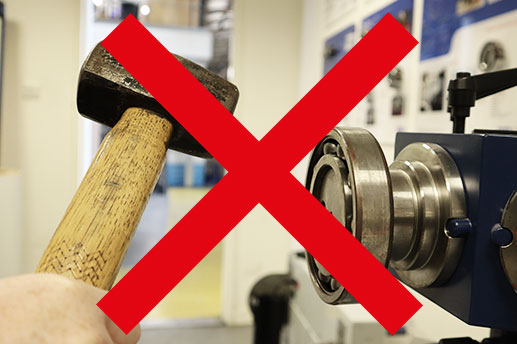
When you’re in a rush or an emergency break down, it can be tempting to replace the failed bearing as fast as possible to get up and running again, no matter the method or means. This may work in the short term, but what if we told you that in the long term, one in six premature bearing failures occur due to poor fitting practices? It might make you think twice about reaching for the closest flame torch, bath, or mallet.
In this article we will outline the most common ways you should AVOID fitting your bearings, and suggest a safe and quick replacement that won’t cost your bearings down the line:
Brute Force
 Picture this: the bearing on your machinery has failed unexpectedly and you desperately need to get a new one fitted before the cost of downtime starts to rack up. Your replacement bearing has arrived same day from ACORN, and you’ve quickly disassembled the machine ready to fit the bearing. Time is moving on, so you reach for the nearest tool, hitting the bearing into place with a mallet.
Picture this: the bearing on your machinery has failed unexpectedly and you desperately need to get a new one fitted before the cost of downtime starts to rack up. Your replacement bearing has arrived same day from ACORN, and you’ve quickly disassembled the machine ready to fit the bearing. Time is moving on, so you reach for the nearest tool, hitting the bearing into place with a mallet.
Now, although the bearing is set in place and the machine is back up and running, what you don’t see is the internal damage that’s been done to the bearing due to misalignment, soon to cause the premature failure of the bearing.
Best solution: Replace with: Fitting Kits
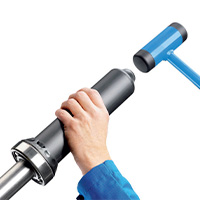 Rather than risk unexpected break down occurring again, it is much quicker, easier, and safer to use a mechanical fitting method that uses controlled force to fit the bearing. We would suggest tools like the SKF TMFT 36 bearing fitting kit that can be used to fit bearings from 10 - 55 mm (0.39 - 2.17 in) bore diameter. By using the correct combination of impact ring and sleeve, bearings can quickly be fitted to the shaft without compromising the bearings raceways or rolling elements.
Rather than risk unexpected break down occurring again, it is much quicker, easier, and safer to use a mechanical fitting method that uses controlled force to fit the bearing. We would suggest tools like the SKF TMFT 36 bearing fitting kit that can be used to fit bearings from 10 - 55 mm (0.39 - 2.17 in) bore diameter. By using the correct combination of impact ring and sleeve, bearings can quickly be fitted to the shaft without compromising the bearings raceways or rolling elements.
Naked Flame
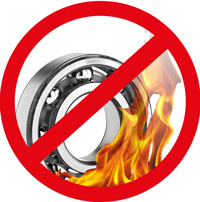 One of the most dangerous options for heating a bearing is with a naked flame. Whether it be from a blow torch or other means, this method is never recommended. Not only is this method incredibly dangerous but using an open flame will heat the bearing unevenly which can cause the inner and outer rings to deform. This leaves the bearing vulnerable for many types of damage that can cause premature bearing failure.
One of the most dangerous options for heating a bearing is with a naked flame. Whether it be from a blow torch or other means, this method is never recommended. Not only is this method incredibly dangerous but using an open flame will heat the bearing unevenly which can cause the inner and outer rings to deform. This leaves the bearing vulnerable for many types of damage that can cause premature bearing failure.
Best solution: Replace with Bearing Heaters
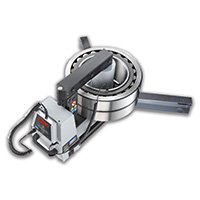 Alternatively, induction bearing heaters are a fast, safe, and simple solution that is much more effective than using a naked flame. Induction bearing heaters work by passing a high frequency oscillating current through the bearing or workpiece when placed in the heaters magnetic field. The current causes the workpiece or bearing to heat and expand, allowing it to slide easily onto the shaft.
Alternatively, induction bearing heaters are a fast, safe, and simple solution that is much more effective than using a naked flame. Induction bearing heaters work by passing a high frequency oscillating current through the bearing or workpiece when placed in the heaters magnetic field. The current causes the workpiece or bearing to heat and expand, allowing it to slide easily onto the shaft.
Induction bearing heaters are available for almost all sizes of bearing, with several types of heaters available from large size to portable, making them a convenient heating solution. We recommend the SKF TWIM 15 portable bearing heater as it is the perfect solution for bearings and other metallic components up to 20kg. Due to its portability, it cuts the need for more ‘convenient’ heat methods such as naked flames.
Oil Bath
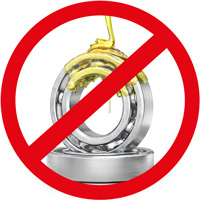 Another common technique for heating bearings is using an oil bath as a method. This is not a recommended method for heating bearing, not only due to the severe safety implications, but it can also leave your bearings vulnerable to premature failure. Although this method may heat bearings more evenly than using a flame, it is likely that the oil will contaminate the bearing and its lubricant.
Another common technique for heating bearings is using an oil bath as a method. This is not a recommended method for heating bearing, not only due to the severe safety implications, but it can also leave your bearings vulnerable to premature failure. Although this method may heat bearings more evenly than using a flame, it is likely that the oil will contaminate the bearing and its lubricant.
Best solution: Replace with: Hydraulic Fitting Kit
 Hydraulic fitting kits come in two different forms: oil injection method and drive-up method. These fitting kits are suitable for use in bearings with tapered shaft seats or adapter and withdrawal sleeves. Drive-up hydraulic fitting kits feature a hydraulic nut which is placed onto a threaded section of the shaft, resting against the inner ring of the bearing. Oil is then pumped into the hydraulic nut using a hydraulic pump, to drive it up the shaft, moving the bearing with it. The oil injection method is self-explanatory, as a thin layer of oil is injected through both ducts and distribution grooves between the bearing and its seat, allowing the bearing to be easily slid into place.
Hydraulic fitting kits come in two different forms: oil injection method and drive-up method. These fitting kits are suitable for use in bearings with tapered shaft seats or adapter and withdrawal sleeves. Drive-up hydraulic fitting kits feature a hydraulic nut which is placed onto a threaded section of the shaft, resting against the inner ring of the bearing. Oil is then pumped into the hydraulic nut using a hydraulic pump, to drive it up the shaft, moving the bearing with it. The oil injection method is self-explanatory, as a thin layer of oil is injected through both ducts and distribution grooves between the bearing and its seat, allowing the bearing to be easily slid into place.
We recommend the SKF HMV 28E hydraulic nut as it is a small, portable piece of equipment that is easy and safe to use, without worrying about hot oil and other dangers.
ACORN is proud to be an authorised distributor for SKF products and can supply your maintenance products usually within 24 hours if not sooner, for more information on the range of maintenance products we offer, talk to our knowledgeable sales team today.
